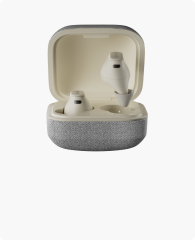CIC (Completely-in-the-Canal) hearing aids are tiny and nearly invisible devices that sit deep inside your ear canal. For those who want something discreet, lightweight, and easy to wear, CIC hearing aids are indeed great choices. Are you new to CIC hearing aids? This blog is a complete guide to check out. We will break down how CIC hearing aids work, what they cost, their pros and cons, how they compare to IIC models, tips for choosing the right one, and how to keep them clean and working at their best.
🚀 Navigate This Post
- ➤ Part 1: What Are CIC Hearing Aids?
- ➤ Part 2: CIC Hearing Aids Price
- ➤ Part 3: Why Wear CIC Hearing Aids — Pros & Cons
- ➤ Part 4: CIC vs IIC: What is the Difference Between CIC and IIC Hearing Aids?
- ➤ Part 5: Best CIC Hearing Aids — How to Choose the Right One?
- ➤ Part 6: How to Maintain the CIC Hearing Aids?
- ➤ Frequently Asked Questions
You may also be interested in:
- Comprehensive Guide: Everything You Need to Know about Hearing Aids
- Best Hearing Aids to Reduce Background Noise for Seniors
- How Long Do Hearing Aids Really Last? Here’s What You’re Doing Wrong
Part 1: What Are CIC Hearing Aids?
Completely in the canal hearing aids (CIC) are tiny devices designed to fit deep inside your ear canal. Unlike larger models such as BTEs (Behind-the-Ear) or ITEs (In-the-Ear) that rest behind or fill the outer part of your ear, CIC hearing aids sit entirely in the canal. This makes them almost invisible while still delivering clear, natural sound.

CIC hearing aids usually have components as follows:
Microphone: Pick up sound from your surroundings. Most CIC models have one microphone due to their small size.
Computer Processor: Also known as the signal processor or microchip, which analyzes and processes sounds based on your hearing needs.
Amplifier (Built into the Processor): Boost the volume of processed sounds for clearer hearing.
Speaker (Receiver): Deliver the amplified sound directly into your ear canal.
Battery Door: House the battery that powers the device (rechargeable/disposable).
Removal Wire: A small curved wire to insert or remove the device comfortably.
With a completely-in-the-canal hearing aid, your outer ear keeps performing its natural function, which funnels sound down the ear canal. Here, CIC hearing aids process and amplify these sounds based on your hearing loss and the surrounding environment. Since CICs sit close to your eardrum, they often provide a more natural hearing experience.
Want to learn more about different types of hearing aids? Visit our everything about hearing aids guide.
Part 2: CIC Hearing Aids Price
CIC hearing aids usually cost between $1,000 and $4,000 per pair. The hearing aids pricing is primarily subject to the brand, features (like Bluetooth or rechargeability), and whether they are prescription or over-the-counter (OTC).

Here’s a rough breakdown of completely in the canal hearing aids:
- Basic OTC CIC models from brands like MDHearing, Eargo, or Lexie generally start at around $200 to $800 per pair.
- Mid-range CIC hearing aids with extras like tinnitus relief or rechargeability often cost $1,000 to $2,500 per pair. Models in this range can be found from brands like Starkey, Widex, and Phonak.
- High-end CIC hearing aids from premium brands like Oticon, Signia, or ReSound, with Bluetooth, activity tracking, and advanced sound processing, can reach $3,000 to $4,000+ per pair.
Part 3: Why Wear CIC Hearing Aids — Pros & Cons
CIC hearing aids are a perfect blend of performance, comfort, and invisibility. You can learn more about CICs through the pros and cons.
Pros:
- One of the smallest types of hearing aids with near invisibility, allowing users to feel more confident in social settings.
- Sit inside the ear canal and provide a more natural listening experience.
- Many rechargeable CIC hearing aids reduce the hassle of changing tiny batteries.
- Some newer CIC Bluetooth hearing aids allow for seamless streaming and phone calls.
- No wires or external parts to snag on clothing or masks. CIC hearing aids are great for an active lifestyle.
- Tinnitus sufferers may find relief with CIC models that include masking features.

Cons:
- Smaller size means fewer controls and less amplification power.
- Some CIC hearing models may lack volume adjustment or directional microphones.
- Smaller batteries typically mean shorter battery life.
- Their small size might not be ideal for users with dexterity issues.
- Moisture and earwax can affect performance more easily due to deep placement.
- While some OTC CIC hearing aids are budget-friendly, the best OTC hearing aids can still be pricey.
Part 4: CIC vs IIC: What is the Difference Between CIC and IIC Hearing Aids?
As you can see, CIC hearing aids are popular for being discreet. But how do they really stack up against other “in-the-ear” styles like IIC and ITC? Generally, CIC, IIC, and ITC hearing aids all sit inside the ear, but they differ in size, visibility, and features.
IIC (Invisible-in-the-Canal) hearing aids are the smallest and most hidden, but still, they typically offer fewer features. CIC (Completely-in-the-Canal) models manage to strike a balance, but some of them might be equipped with Bluetooth or rechargeable batteries. ITC (In-the-Canal) aids are slightly larger and more visible, with more power and easier controls.

CIC, IIC, and ITC, which one is the best invisible hearing aids? It really depends on your lifestyle and hearing needs. Let’s break down the key differences in the comparison below.
| Feature | CIC (Completely-in-the-Canal) | IIC (Invisible-in-the-Canal) | ITC (In-the-Canal) |
|---|---|---|---|
| Visibility | Mostly hidden, slightly visible | Fully hidden in the ear canal | Partially visible in the ear canal |
| Fit Depth | Deep in the canal | Deeper than CIC | Shallow, partially fills the canal |
| Size | Tiny | Ultra-tiny | Small to medium |
| Comfort | Custom fit, comfortable | Very snug fit | Slightly more room for comfort |
| Suitability for Hearing Loss | Mild to moderately severe | Mild to moderate | Mild to severe |
| Bluetooth Support | Available in some models | Rarely available | Common |
| Rechargeable Options | Yes (in some models) | Rare | Often available |
| Tinnitus Relief | Available in select models | Limited | Widely available |
| Ease of Handling | Moderate | May be difficult due to size | Easier to handle than CIC/IIC |
| Best For | Those seeking discreet tech with features | Users wanting max invisibility | Users who want a balance of power and size |
Part 5: Best CIC Hearing Aids — How to Choose the Right One?
Choosing the best CIC hearing aids can be difficult, especially with so many options out there. It’s not just about browsing a product list. If you don’t know where to begin, here’s what you should keep in mind:
1. Understand Your Hearing Needs
CIC hearing aids typically work best for mild to moderate hearing loss. That’s why you need to start by knowing the severity of your hearing loss. You are recommended to take a hearing test from an audiologist to narrow down your options and avoid unnecessary expenses.
2. Identify the Features That Matter Most
The best CIC hearing aids are more than just small; they can be smart! You can look for the following features as per your needs:
- CIC hearing aids with Bluetooth for wireless streaming, phone calls, and media.
- Intelligent AI noise filtering that adapts to different environments.
- Long-lasting CIC rechargeable hearing aids to avoid the hassle of constantly charging.
- Mobile app support for fast sound adjustments.
- Tinnitus management features to ease ringing in the ears.

3. Fit and Long-Term Comfort
Since CIC hearing aids sit deeply in your ear canal, it’s important to go for models designed with medical-grade, skin-friendly materials. A proper fit can better enhance sound clarity, reduce feedback (whistling), and ensure they won’t fall out.
4. Consider Your Budget
Generally, OTC models can be a cheaper entry point if you need general support without a prescription. However, prescription CIC hearing aids are ideal if you want custom programming, advanced features like tinnitus relief, and a personalized fit for optimal comfort and performance.
If you prefer easier handling, longer battery life, or a more budget-friendly option, an ITE (In-the-Ear) model might suit you better. For instance, Cearvol Diamond X1, this compact yet powerful ITE hearing aid offers clear sound quality and reliable performance for mild to moderate hearing loss.
Key features of Cearvol Diamond X1
- Automatically adjusts sound to your environment using 16-channel WDRC and AI-powered noise reduction, delivering clearer, more natural audio wherever you go.
- Bluetooth 5.3 to seamlessly connect to iOS & Android devices for calls, music, and more.
- Rechargeable long battery to provide up to 12 hours per charge, plus 24 hours from the charging case.
- Blend in seamlessly for a discreet fit and stay comfortable all day.
Part 6: How to Maintain the CIC Hearing Aids?
Your CIC hearing aids require proper maintenance for long-term performance. Here’s a complete routine to follow:
- Wipe them daily with a soft, dry cloth to remove earwax or debris.
- Use a cleaning brush to gently clear the microphone port and sound outlet.
- Store them in a dry, protective case when not in use.
- Schedule periodic check-ups for professional deep cleaning or reprogramming.
For step-by-step instructions, check out our full guide on how to clean hearing aids.









Leave a comment
All comments are moderated before being published.
This site is protected by hCaptcha and the hCaptcha Privacy Policy and Terms of Service apply.